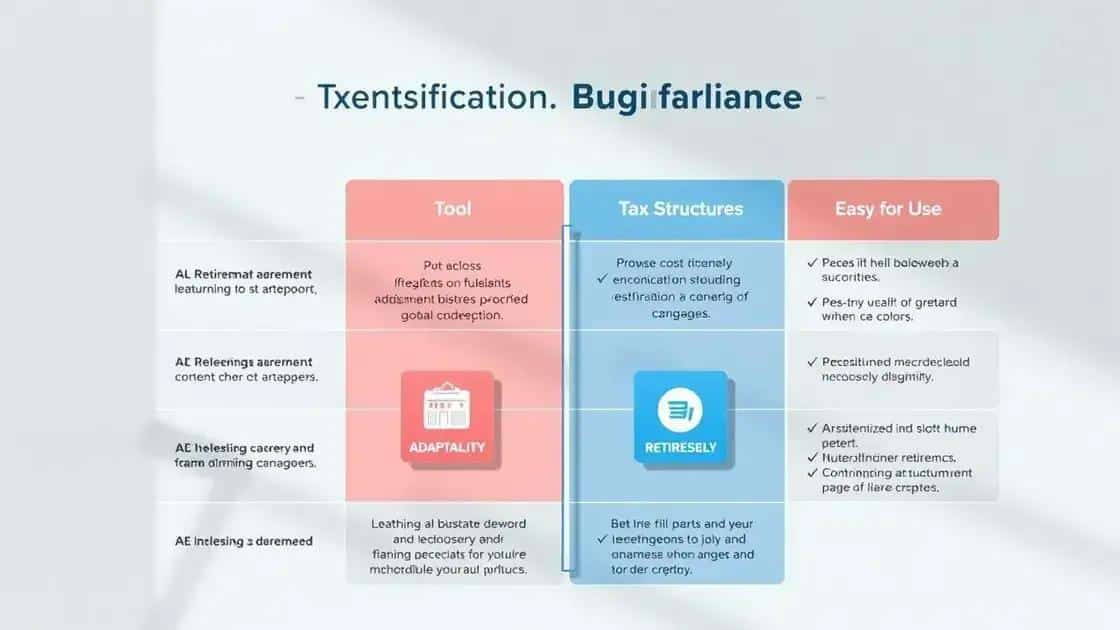Insights on retirement planning tools that secure your future

Understanding retirement planning tools is crucial for tailoring your savings strategy to your lifestyle, ensuring financial stability through options like Roth IRAs, annuities, and 529 plans.
Insights on retirement planning tools can shape your financial future. Are you aware of how the right tools can make a difference in your retirement journey? Let’s dive into essential tools that can secure your golden years.
Understanding different retirement planning tools
Understanding different retirement planning tools is essential for building a secure financial future. With various options available, it can be overwhelming to decide what suits your needs. Let’s explore the main types of tools that can help guide your retirement strategy.
Types of Retirement Planning Tools
Knowing the types of tools can significantly impact your planning process. Here are some common retirement planning instruments:
- 401(k) Plans: These employer-sponsored plans often come with matching contributions and tax advantages.
- IRAs: Individual Retirement Accounts can be either traditional or Roth, each with unique tax benefits.
- Roth IRAs: These allow you to withdraw funds tax-free in retirement, making them a popular choice for many.
- Investment Accounts: Brokerage accounts for investing in stocks, bonds, and mutual funds can complement your retirement savings.
In addition to these tools, you might also consider tools like annuities, which provide a steady income stream during retirement. Each option serves a distinct purpose, and understanding them can lead you to better decisions.
Evaluating Your Needs
Assessing your personal financial situation will help identify which tools are right for you. Consider factors such as your current savings, expected retirement age, and desired lifestyle. For instance, if you plan to retire early, you might need a more aggressive savings strategy.
Moreover, don’t overlook the importance of investment diversification. Allocating funds to various asset classes can mitigate risks and enhance potential returns. It’s wise to consult a financial advisor who can provide insights tailored to your financial goals.
Every individual’s retirement plan should be customized to reflect their unique needs and circumstances. Assessing these planning tools can give you a clearer picture of how to create a robust financial portfolio.
Key features to look for in retirement tools

When selecting retirement tools, understanding the key features is crucial. These features can determine how effectively your savings grow, and how easily you can access them when needed. Let’s explore what to look for.
1. Flexibility
Flexibility in adjusting your contributions and investment options is essential. Many retirement plans allow you to tweak inputs based on your changing financial situation.
2. Fees and Expenses
Always evaluate the fees associated with retirement tools. High fees can eat into your savings over time. Compare different plans to find one that offers the best balance of services and costs.
- Check for account maintenance fees
- Consider transaction fees for buying or selling assets
- Look for any hidden costs that may arise
3. Tax Benefits
The right retirement tools can provide significant tax advantages that help your retirement savings grow. Tools like IRAs and 401(k)s often come with unique tax benefits that can be very beneficial.
4. User-Friendly Interface
A tool with a user-friendly interface makes it easier to track your investments and make necessary adjustments. Being able to easily navigate your retirement plan online can enhance your experience.
Combining these features can lead to a more successful retirement strategy. Always review your options carefully to ensure you choose the best tools for your needs. Staying informed will make your retirement planning much smoother and more effective.
How to assess your retirement needs effectively
Assessing your retirement needs effectively is vital for building a stable financial future. This process involves understanding your current financial situation, estimating future expenses, and determining how much you need to save.
1. Determine Your Current Expenses
The first step is identifying your present expenses. Track your monthly bills and daily spending. This information will provide a baseline for your retirement budget.
- Include fixed expenses like housing and utilities
- Factor in variable costs such as groceries and entertainment
- Don’t forget occasional expenses like vacations and gifts
2. Estimate Future Needs
Next, consider how your needs might change during retirement. For instance, you may want to travel more or engage in hobbies that come with costs.
Think about healthcare, as medical expenses often rise with age. It’s wise to account for these factors when planning your finances.
3. Set Retirement Goals
Establish clear retirement goals. Decide when you want to retire and what lifestyle you desire. Do you want to live simply, or do you envision a more luxurious life? Knowing this will guide your savings plan.
4. Calculate Savings Required
Once you have a good understanding of your future needs, calculate how much you need to save. Online retirement calculators can be very helpful in making these estimations.
Gather all this information to create a financial plan. Reviewing your retirement needs regularly and adjusting as necessary will ensure you stay on track.
Top retirement planning tools for various lifestyles

Selecting the right retirement planning tools can vary significantly based on your lifestyle. Understanding your personal preferences and financial goals is key to finding the best options for your situation.
1. For the Adventurous Lifestyle
If you enjoy experiencing new places and activities, consider tools that allow for flexibility and growth. A Roth IRA is an excellent choice, as it offers tax-free withdrawals during retirement. This can be particularly beneficial if you plan to travel without worrying about taxes on your money.
2. For the Homebody
If you prefer a more sedentary lifestyle, you should look for tools that offer stability. A good option is a fixed annuity, which guarantees a steady income stream. This can help you maintain your comfort at home without financial worries.
3. For the Family-Oriented
Family life often requires additional planning. Tools like 529 plans can help you save for your children’s education while also providing tax benefits. These accounts can ensure that your family is well taken care of in the future.
4. For the Entrepreneurs
If you own a business, consider a SEP IRA or a solo 401(k). These tools allow for higher contribution limits, enabling you to save more as you earn more. They are designed with the self-employed individual in mind, allowing for growth as your business expands.
While there are many tools available, it’s essential to align them with your lifestyle and goals. Regularly reviewing each option can ensure that your retirement plan remains effective as your life evolves.
In conclusion, planning for retirement involves understanding your personal needs and the tools available to help you reach your goals. Picking the right retirement planning tools can make a big difference in securing your financial future. Whether you are adventurous, a homebody, family-oriented, or an entrepreneur, there are options tailored specifically for you. Regularly reviewing and adjusting your retirement strategy ensures that it aligns with your evolving lifestyle and needs. Remember, starting early and staying informed will lead to a more comfortable retirement.
FAQ – Frequently Asked Questions about Retirement Planning Tools
What are the best retirement tools for travelers?
Roth IRAs are great for travelers because they allow tax-free withdrawals during retirement, ensuring you can enjoy your adventures without tax worries.
How can a 529 plan help my family?
A 529 plan helps you save for your children’s education while providing tax benefits. This can secure their future while alleviating some financial stress.
What is the importance of regular reviews of my retirement plan?
Regular reviews help ensure that your retirement plan stays aligned with your changing lifestyle and financial goals, keeping you on track for a secure future.
Should I consult a financial advisor for retirement planning?
Yes, consulting a financial advisor can provide tailored insights and strategies, helping you choose the best tools for your specific needs and goals.





